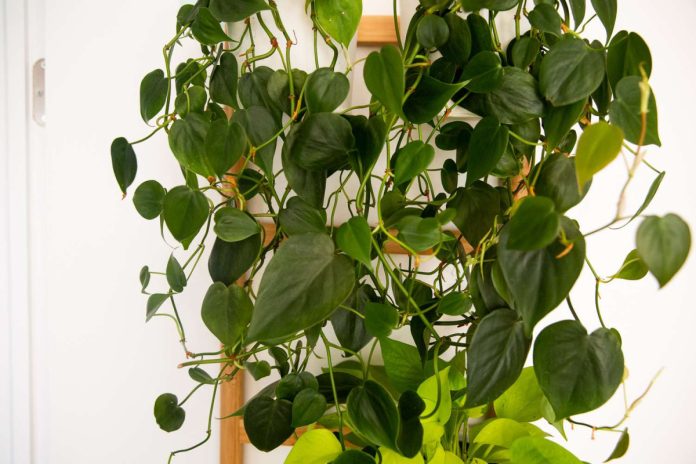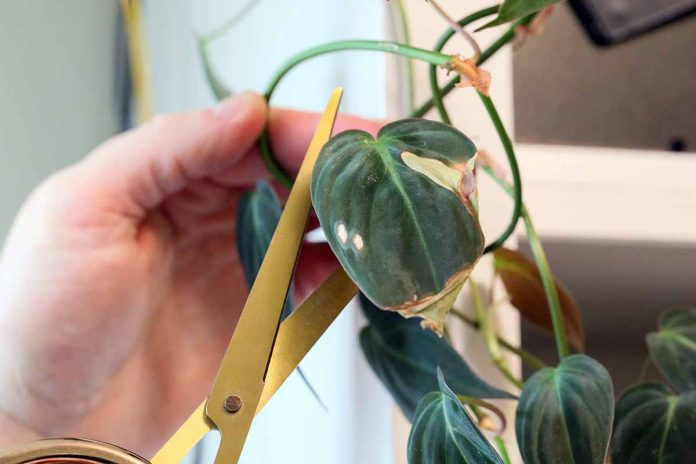Philodendrons are one of the most popular houseplants for a reason. Their lush green foliage and ease of care make them the perfect addition to your home decor. However, sometimes the plants seem to stop growing and look limp… If you are tired of your philodendron looking pale, don’t worry, we will share tips on how to make your vine more lush and healthy.
To begin with, it should be noted that all philodendrons belong to one of two categories: climbing or bush. This article will focus on Philodendron hederaceum, one of the most popular flower varieties. These climbing plants produce waxy, dark green, heart-shaped leaves. It is sometimes mistaken for the Pothos plant due to many similar characteristics, but it is a completely different species.
Many gardeners struggle to make their philodendrons look as lush as they want them to be. But still, instead of dense foliage and long stems, they get thin and weak vines. Let’s figure out why this happens.
1. Philodendron loves well-drained soil.
Philodendron cordifolia thrives in a well-drained soil mixture. Be sure to choose soil that contains a large amount of high-moor peat. Add perlite to the finished substrate to improve drainage and help the plant develop well.
2. Make sure the plant gets enough light
Philodendrons thrive in at least 5 hours of indirect sunlight per day. If this norm is met, then it will have large, healthy leaves and strong vines. It will be optimal to grow philodendron in an eastern window, with soft morning light and intense afternoon light for 2-3 hours.
In a dark corner of the room, philodendrons will have slower growth and the leaves will lose their variegation. Do not keep the plant near a south-facing window, as constant sun can burn the foliage.
During periods with less sun, plants do better with natural light than with LED lighting. Therefore, it is better to simply move them closer to the window.
3. No drafts or cold
Philodendrons grow best in a stable temperature range of 19-29°C, without being exposed to very hot or cold temperatures. Also, keep them away from cold drafts and air conditioners. Do not expose the plant to temperatures below 12°C for an extended period of time.
4. Provide moisture and regular watering
Philodendron cordifolia is a plant that comes from humid tropical regions. For successful growth, it requires an air humidity level of about 70%. This can be achieved by periodically spraying with a spray bottle 2-3 times a day. This can temporarily increase humidity levels, but it is important to avoid getting the leaves too wet as this can lead to fungal diseases and other problems.
One way to increase humidity is to group plants. Water vapor released by one specimen can be absorbed by another, creating a wetter environment for all its neighbors.
To make caring for your philodendron easier, purchase a humidifier and keep it on all the time. In such conditions the plant will thrive. When using a humidifier, it is important to clean it regularly to prevent the growth of bacteria and other harmful microorganisms.
Water the plants deeply every one to two weeks. If your philodendron leaves turn yellow and begin to fall off, you are probably over-watering the substrate. To avoid this, allow the top layer of soil to dry out completely between waterings.
5. Fertilize when needed.
When you buy a philodendron, the soil in which it was grown should contain enough nutrients to start with. However, in a few months these reserves will be used up. Over time, this leads to a slowdown or complete stop of growth. Pale young leaves usually indicate that the plant is not getting enough nutrients, most often potassium and magnesium.
When feeding philodendron, apply fertilizer for decorative foliage once or twice during the active growing season: in spring and summer. During the winter months, reduce or completely stop fertilizing. If you notice new leaves appearing on your Philodendron cordata, it’s time to resume feeding.
It should be remembered that an excess of fertilizers leads to the accumulation of salts in the soil. This can harm the plant or even lead to immediate death.
6. Don’t forget about pruning
You can let the stems grow as they please, or work to create a bushy, dense shape. Although the flower is slow-growing, the Philodendron cordifolia will require pruning in any case. To help the plant produce more foliage rather than stretch out, trim the tops of the stems. This will cause the flower to send out more side shoots and increase density. For propagation, you can also root these cuttings in water.
It is also important to periodically remove old or diseased leaves. This will help the plant redirect its energy toward producing new, healthy foliage.
Trimming will also be required to control the size. Although the philodendron grows slowly, it can still become too large for its space. If this happens, you can trim the stems and leaves.
7. Replant every 2-3 years
If you properly care for your philodendron, it will be fine with replanting once every 2-3 years. It is important to repot plants to prevent root rot and maintain root health. You may need to buy a larger pot due to the vigorous growth of leaves and roots.
For transplantation :
- Fill the new pot three-quarters full with a high-quality, well-draining potting mix.
- Dig a hole in the center where you place the roots.
- Gently loosen the soil around the roots with your hands (do not use a trowel as this will damage the roots).
- Remove the philodendron from the pot and carefully place it in a new one.
- Add soil until the roots are completely covered.
- Water the plant.
8. Watch out for pests
Philodendrons can be susceptible to common pests such as mealybugs, spider mites and aphids. Keep your plant healthy to prevent it from falling prey to insects. If necessary, you can also spray the shoots with an insecticide or acaricide.




